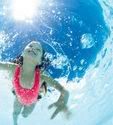 National Safe Kids week officially begins tomorrow, May 6th. This year they're highlighting pool and water safety--a good topic to brush up on if you have children that will be around pools or other swimming areas this summer. And it's not just swimming lessons and water wings that parents need to be concerned about. More after the jump.
National Safe Kids week officially begins tomorrow, May 6th. This year they're highlighting pool and water safety--a good topic to brush up on if you have children that will be around pools or other swimming areas this summer. And it's not just swimming lessons and water wings that parents need to be concerned about. More after the jump.
When it comes to safety, most parents do not know that drowning is one of the top two causes of accidental death among children. National Safe Kids Week activities and communications will educate parents and children about the steps they can take to help prevent pool and spa injuries and deaths and highlight new proposed legislation in this area.There will be a special focus about preventing entrapment, which is a little known risk that has killed at least 33 children and injured almost 100 children between 1985 and 2004.
"Entrapment" obviously isn't referring to the legal definition of the term here. Rather, it's when a child becomes stuck in the pool or spa filter/suction device:
Entrapment occurs when part of a child's body becomes attached to a drain because of the powerful suction of a pool or spa's filtration system. It also can occur when a child's hair or swimsuit gets tangled in the drain or on an underwater object, such as a ladder.
If this sounds a bit familiar, perhaps you heard about it several years ago, when former Secretary of State James Baker's 7-year-old granddaughter died in a home spa during a party:
Baker's granddaughter, Virginia Graeme Baker, died four years ago when she became entrapped in the drain of a spa. It took several adults to help pry her free from the force of the drain, but it was to no avail. She had drowned. This tragedy occurred at a graduation party that was well supervised by scores of adults.
Sadly, this tragedy could have been prevented. As noted, the party was well-supervised, but once some of these high-powered filters get hold of a small child, it takes an incredible amount of force to get them free if the suction isn't able to be broken or the vacuum turned off--so even the best of supervision can fail. However, there are covers available to fit over these drains and filters, and minimize the chances of a child becoming entangled in them. (You also may remember reading about Valerie Lakey's gruesome accident due to a faulty drain cover--her lawyer was former VP candidate John Edwards).
To coincide with National Safe Kids Week, Baker and his daughter have worked with representatives to draft legislation to make pools safer for children:
[The proposal] would provide incentive grants for states that make pool and spa safety devices mandatory - such as drain covers that comply with Consumer Product Safety Commission guidelines, safety vacuum release systems, multiple drains and four-sided fences. At least four states have laws addressing barrier requirements for residential swimming pools, and currently no state has enacted a comprehensive safety law, incorporating all layers of protection, for both residential and public pools and spas.
I haven't read the proposed legislation and therefore I don't necessarily endorse it (though I can't imagine there would be much I'd object to), but whether it passes or not, hopefully this will serve to remind people to simply be careful, and check out pools and spas before their kids jump in.
Once again, I expect someone will claim "fear-mongering," but these statistics are noteworthy:
New research conducted for National Safe Kids Week shows only one third (34 percent) of parents with children aged 14 or under in the household recognize that drowning is one of the top two causes of accidental death among children, and that 66 percent are not at all or only somewhat familiar with the threat of drain entrapment and entanglement. Both of these findings are alarming because research reveals that pool and spa ownership is becoming more popular. One out of two parents report that they have a pool or spa at home (49 percent).
Even though it's highly unlikely something like this will happen to your child, it never hurts to take a minute, read up on it, and determine whether your pool or spa is as safe as it can be--or to double-check about safety devices when your child goes swimming at someone else's house. It takes minimal effort and could, potentially, make all the difference.
Image from http://www.newspaper.unsw.edu.au/archive/05_03_30/images/stories/Staff2…
*For those of you who didn't understand the title, David Blaine is the magician who's spent the week in a giant bubble of water, and apparently has an upcoming special redundantly titled "Drowned Alive," where he'll attempt to hold his breath for 9 minutes. Now *there's* some great TV...

This is a good post-- the other thing people don't realise about children drowning is that they seldom thrash about and cry "Help," as is depicted on TV and in movies. Rather, they just very quietly slip under the water and die. So, stay close!
33 children in 20 years? With how many kids in pools each day? While pools are (relatively) dangerous places for children and drain covers sound like a good idea, there must be more important hazards for the Safe Kids people to worry about!
That figure is for reported entrapment cases alone, and it's thought that it's severely under-reported (because many are simply written up as a drowning). Additionally, entrapment is only one focus--overall, as they mention, drowning is a leading cause of accidental death in children.